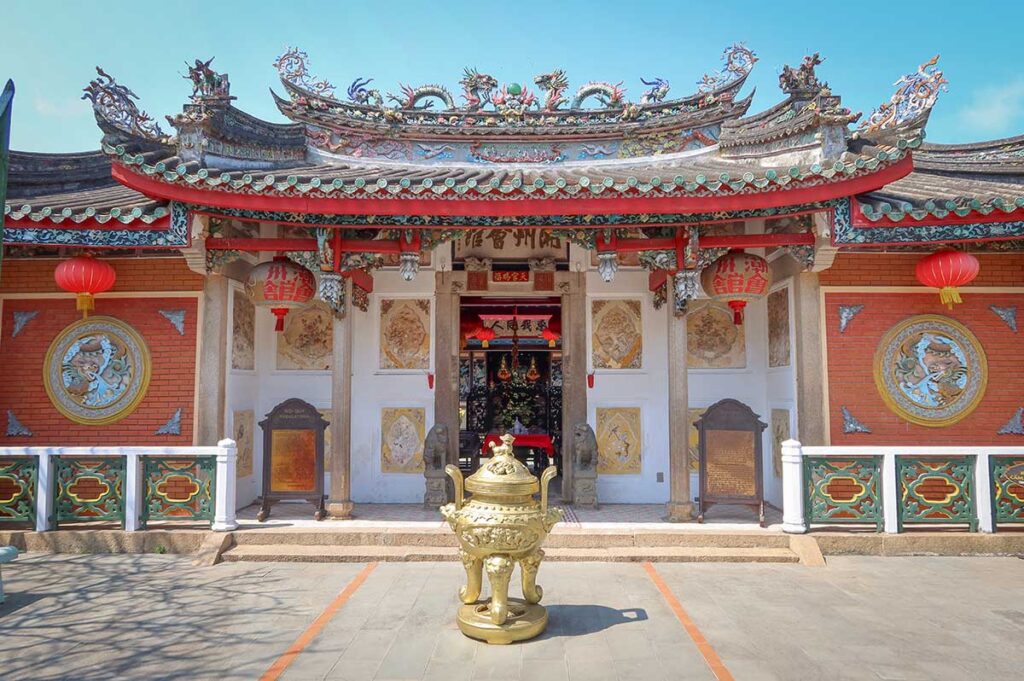What is a Chinese Assembly Hall?
Chinese assembly halls, or hội quán, were built by migrant communities from different regions of China who settled in Hoi An during its golden age as an international trading port. Each group — Fujianese, Cantonese, Hainanese, Teochew, and others — created its own hall to serve as both a spiritual temple and a community center. These spaces were used for worshiping regional deities, supporting fellow merchants, hosting events, and preserving cultural traditions.
Because Hoi An welcomed so many traders from China, multiple assembly halls developed — each reflecting the customs and architecture of its founding community. While they share some similarities, each hall is distinct in its deities, decorative style, and atmosphere. Together, they form one of the most fascinating aspects of Hoi An’s multicultural heritage.
Hoi An Walking Tour by Local Guide
- Experience Explore Hoi An’s Ancient Town with an expert local guide and insider stories.
- Includes Market visit, traditional house, colorful temples, and coffee break by electric car.
Historical background
Hoi An flourished as a major Southeast Asian trading port between the 15th and 19th centuries. Its strategic location along the Thu Bon River attracted merchants from across Asia, including a large number of Chinese traders who settled permanently in the town.
These Chinese settlers formed congregations based on their regional origins — such as Fujian, Guangdong, Hainan, and Teochew — and each group built its own assembly hall to serve both spiritual and social needs. Over time, five major Chinese assembly halls were established, each becoming a center for worship, business networking, cultural preservation, and mutual support.
As Hoi An’s port declined in the late 19th century, many of these halls shifted from purely religious use to broader cultural functions. Some were used as schools, meeting halls, or sites for resistance during wartime. Today, they remain important heritage sites — still active in some cases — and are part of Hoi An’s UNESCO-listed Ancient Town.
The 5 Chinese Assembly Halls in Hoi An
Each of Hoi An’s assembly halls was built by a different Chinese community. While they share similarities in function and design, each has its own story, atmosphere, and visual character. Here’s a short overview to help you decide which ones to visit.
1. Phuc Kien Assembly Hall (Fujian)
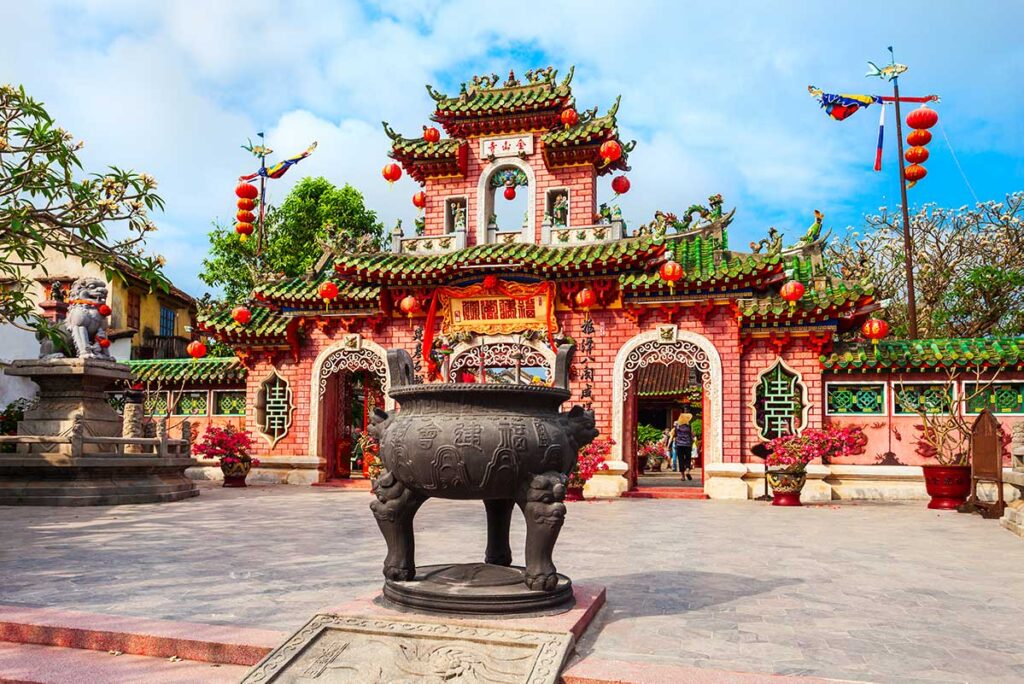
Phuc Kien Assembly Hall, built by the Fujianese community in the late 1600s, is the oldest and most prominent Chinese hall in Hoi An. Originally a small shrine to Mazu (the sea goddess), it grew into a grand complex as the Fujian population expanded and prospered through maritime trade. Over time, it became a center not just for worship, but also for cultural events and business networking.
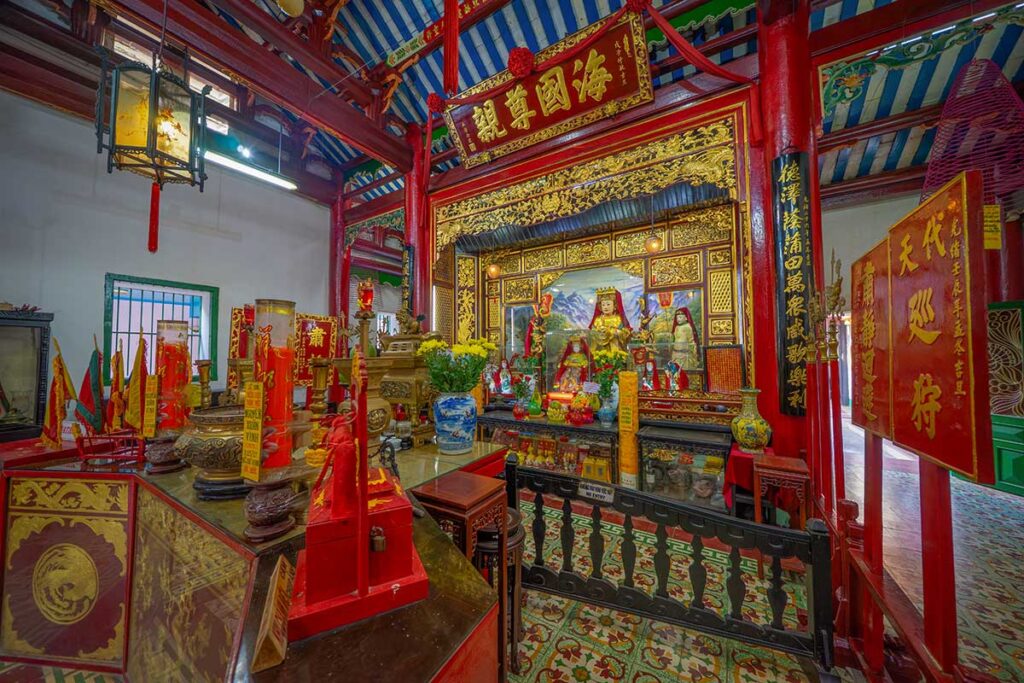
It’s dedicated to Mazu (Thien Hau) and several other deities important to sailors and merchants. Her statue, said to have miraculously washed up near Hoi An, now sits at the heart of the main altar. The hall also features shrines to the God of Wealth, fertility deities, and protective guardians.
This is easily the most visually impressive assembly hall. Expect ornate gates, dragon fountains, expansive courtyards, and intricate tilework. It’s also the most visited, so expect some crowds during peak hours.
→ Read the full guide to Phuc Kien Assembly Hall
2. Cantonese Assembly Hall (Quang Dong)
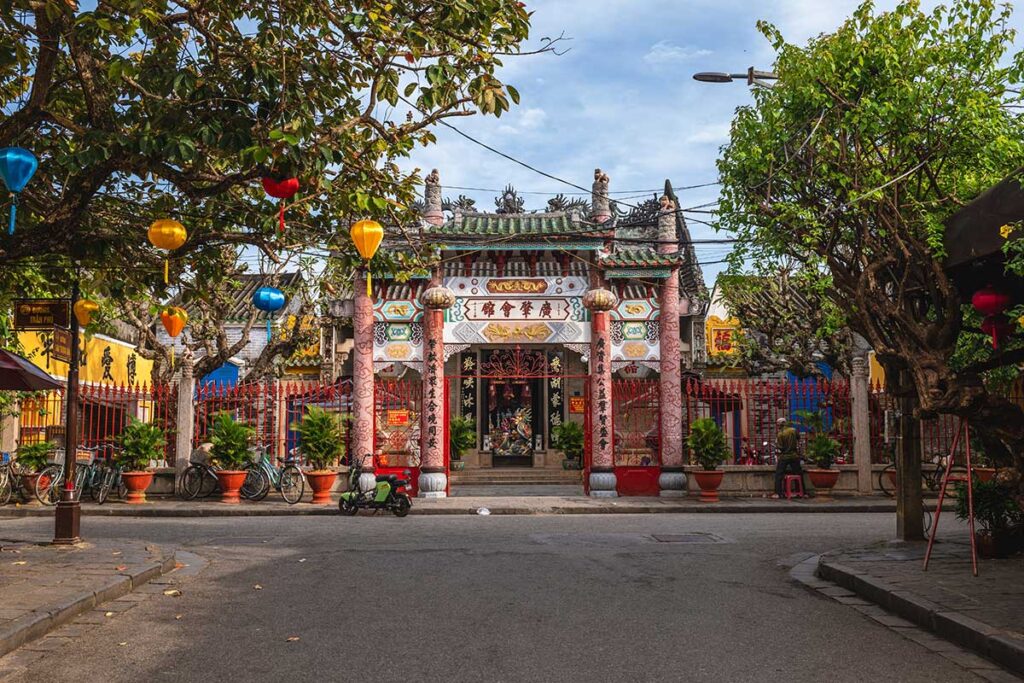
Founded in 1885 by the Cantonese community, this hall was originally dedicated to Mazu and Confucius but later shifted focus to Guan Yu (Quan Cong), a symbol of loyalty, strength, and honor. The hall played a key role in preserving Cantonese culture, language, and community ties during Hoi An’s trading era.
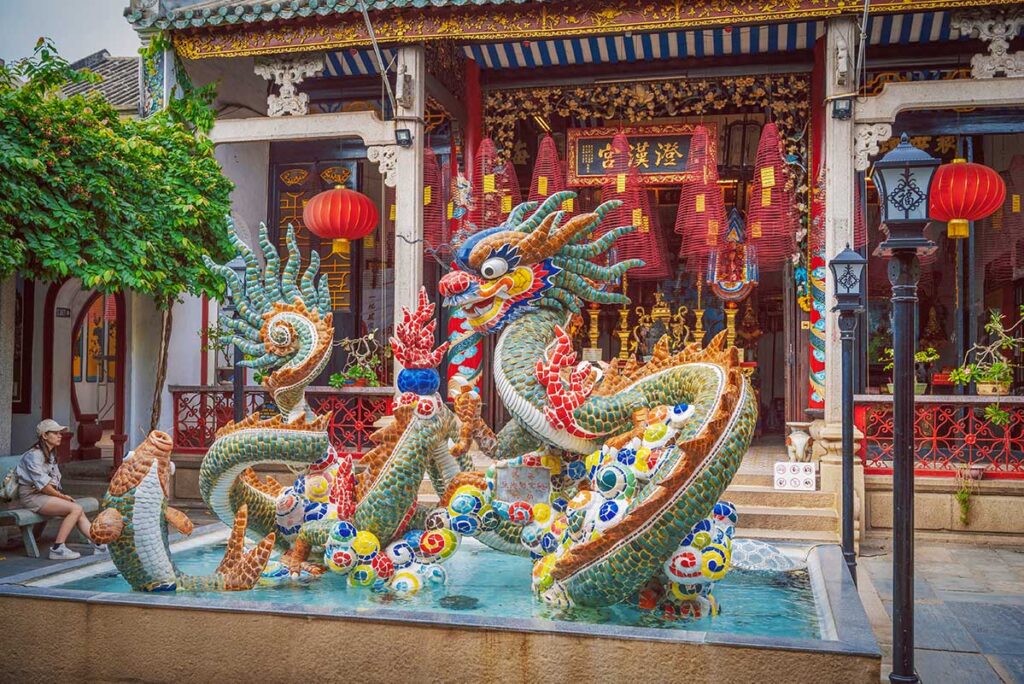
Though smaller than the Fujian Hall, it’s bold in style. Rich red tones, elaborate wood and stone carvings, and the distinctive dragon fountain in the courtyard all give it a strong visual identity. Its architecture follows traditional Chinese design principles, with layered spaces and symbolic decoration.
Located near the Japanese Bridge, it’s highly accessible and frequently visited. That said, it still retains a spiritual atmosphere with worshippers lighting incense throughout the day.
→ Read the full guide to Cantonese Assembly Hall
3. Hai Nam Assembly Hall
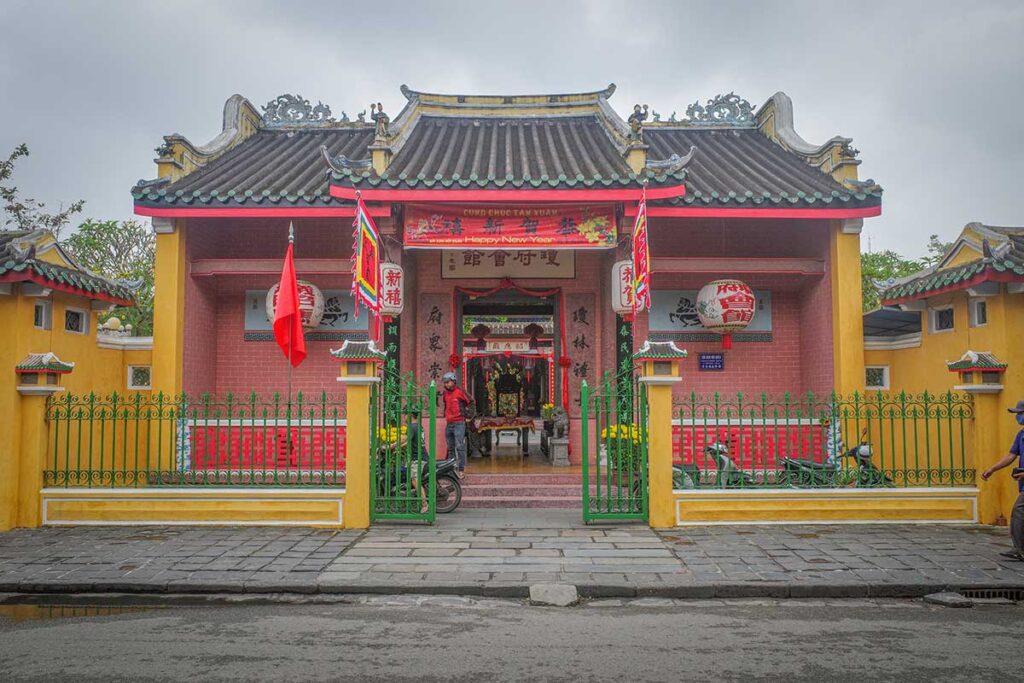
This assembly hall was built in 1875 by the Hainanese community to honor 108 merchants who were mistakenly executed at sea after being falsely accused of piracy. Emperor Tu Duc later issued an apology and allowed the construction of this hall as a place to worship them as deified spirits. That tragic history makes it one of the most unique and solemn sites in Hoi An.
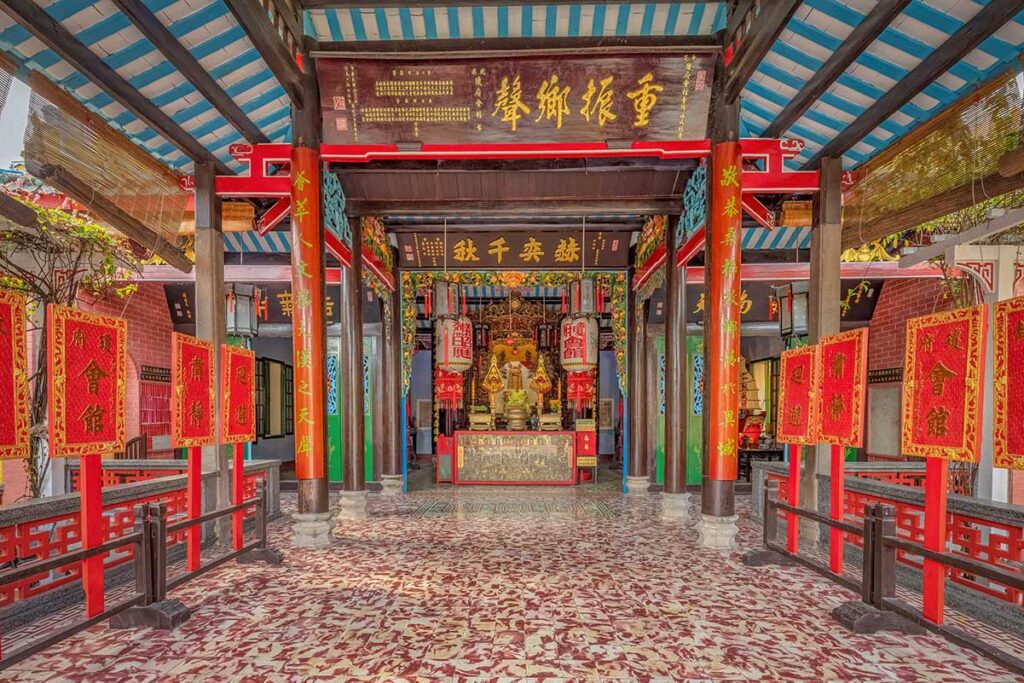
Inside, you’ll find a central altar dedicated to the 108 souls, along with side shrines and symbols reflecting themes of justice, protection, and peace. The hall also served as a gathering space for the Hainanese in Hoi An, though it was always more focused on memorial and worship functions.
Its soft pink facade, tiered courtyard layout, and relatively quiet setting make it a peaceful alternative to the busier halls. It’s ideal for those looking to step off the tourist path while still experiencing local history and culture.
→ Read the full guide to Hai Nam Assembly Hall
4. Trieu Chau Assembly Hall (Teochew)

Built in 1845 by the Teochew (Chaozhou) community from Guangdong, this is one of the smaller halls in Hoi An, but also one of the most refined. It’s dedicated to Phuc Ba (Ong Bon), a powerful sea deity believed to control wind and waves — again highlighting the maritime culture of Hoi An’s early Chinese settlers.
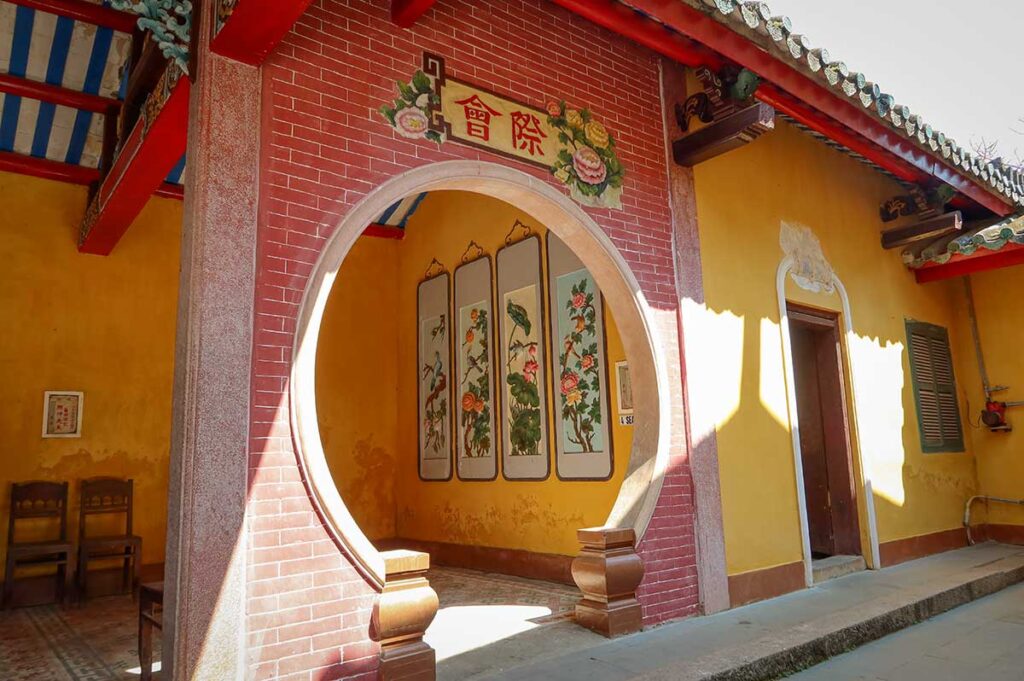
While not as grand as the Fujian or Cantonese halls, Trieu Chau Hall stands out for its intricate wood carvings, painted doors, and symbolic artwork. Much of the material, including the bell and roof tiles, was brought from China. Look out for the Four Gentlemen screen and the vibrant mosaics above the roof ridge.
This hall sees fewer tourists and has a very calm, meditative vibe. It’s a favorite for those interested in detail-rich craftsmanship, hidden corners, and temple photography.
→ Read the full guide to Trieu Chau Assembly Hall
5. Trung Hoa Assembly Hall (Ngu Bang)
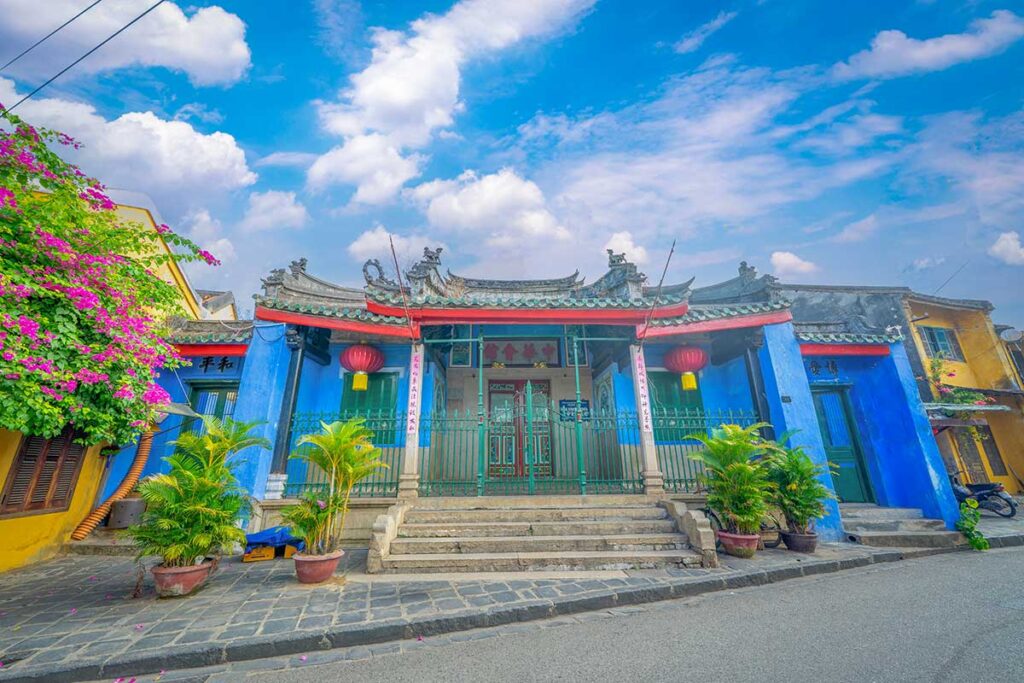
Also called the Five Congregations Hall or Duong Thuong Hall, this is the only assembly hall in Hoi An that represented all five Chinese communities: Fujianese, Cantonese, Teochew, Hainanese, and Hakka. Built in 1741, it served as a shared temple, meeting space, and later even a school and cultural hub. It’s a key symbol of cross-community unity.
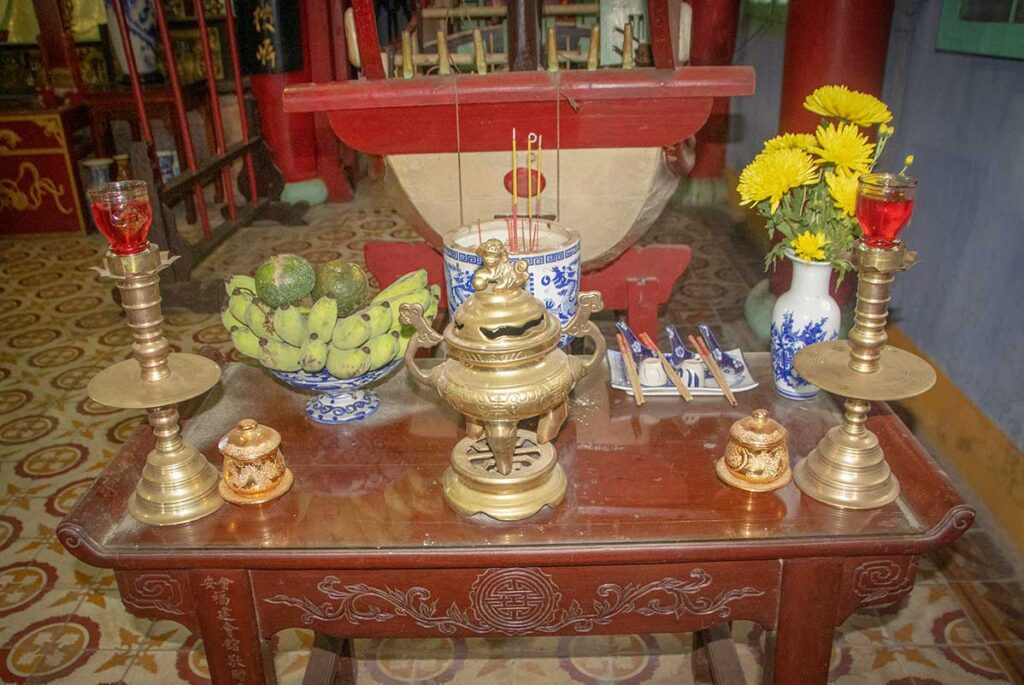
The hall is dedicated to Mazu but also includes shrines to Confucius, Quan Cong, and other spiritual figures important to multiple groups. During the colonial era and even wartime, it adapted to new roles — from education to resistance — and today still hosts language classes and cultural events for Hoi An’s Chinese-Vietnamese population.
Architecturally, it’s more subdued than the others, but the blue-painted facade and open layout make it distinct. It’s also the only one that’s free to enter, making it an easy and worthwhile addition to any Ancient Town walk.
→ Read the full guide to Trung Hoa Assembly Hall
Hoi An Ancient Town ticket – What’s included?
You don’t need a ticket just to walk around Hoi An Ancient Town — the streets, shops, cafés, and riverside areas are all freely accessible. But if you want to enter historical buildings like assembly halls, old merchant houses, museums, or traditional craft centers, you’ll need to buy the official Hoi An Ancient Town ticket.
Each ticket costs 120,000 VND (about 5 USD) and allows entry to five sites total:
- 3 attractions of your choice (such as assembly halls)
- 2 fixed sites from a set list selected by the tourism board
The ticket is valid for 24 hours from the time of issue, so plan ahead to make the most of it.
If you’re interested in visiting the assembly halls, here’s how they’re categorized:
| Assembly Hall | Ticket Required? |
|---|---|
| Phuc Kien (Fujian) | ✔️ Yes |
| Cantonese (Quang Dong) | ✔️ Yes |
| Trieu Chau (Teochew) | ✔️ Yes |
| Hai Nam | ✔️ Yes |
| Trung Hoa (Ngu Bang) | ❌ Free |
Besides assembly halls, the ticket also grants access to:
- Traditional merchant houses
- Small local museums (e.g. Museum of Folk Culture)
- Ancient temples and pagodas
- Art performance centers (with music or dance shows)
Tip: Since you can only pick three attractions freely, choose carefully. If assembly halls are a priority, consider combining your ticket with a few standout houses or temples. And don’t forget that Trung Hoa Assembly Hall is free — a great bonus if you’re trying to stretch your ticket value.
Which Assembly Halls are best to visit with the ticket?
If you only have one ticket and want to visit assembly halls, you’ll need to choose wisely — it only covers 3 halls of your choice (plus 2 fixed sites). Here’s a practical breakdown to help you decide based on your interests:
- Best overall: Phuc Kien (Fujian) Assembly Hall – The largest, most detailed, and visually stunning. A must-see for most travelers.
- Second pick: Cantonese Assembly Hall – Striking architecture, a central location near the Japanese Bridge, and bold interior decorations.
- Third choice:
- Go for Trieu Chau (Teochew) if you like quiet, decorative spaces and intricate woodwork.
- Choose Hai Nam if you’re interested in history and want to explore a memorial hall with a powerful backstory.
Tip: Trung Hoa Assembly Hall (Ngu Bang) is completely free to enter and located close to the others — a great bonus stop to round out your experience.
Bonus tip: You can always buy a second ticket if you want to visit all four ticketed halls (and more temples, museums, or houses). It’s still good value for what you get, especially if you’re spending a full day exploring the Ancient Town.
Tips for visiting Chinese Assembly Halls in Hoi An
A few practical tips to help you make the most of your visit to the assembly halls — whether you’re exploring one or planning to see them all.
How to get there
All five halls are located within the Hoi An Ancient Town, so they’re easily walkable once you’re inside. If you’re staying outside the Old Town, take a taxi, Grab, or bicycle to the nearest entrance and walk from there. No need for transport between halls — they’re close together along Tran Phu and nearby streets.
Get a ticket in advance
You’ll need an Ancient Town ticket to enter most of the assembly halls. These are sold at official ticket counters at the main entrances to the Old Town. It’s best to buy one before you start your day to avoid interruptions.
Check opening hours
Most halls are open from around 7:00 AM to 5:00 or 6:00 PM. Keep in mind that even though the town lights up beautifully at night, the halls are closed by then, so plan accordingly.
Best time to visit
The early morning (before 9 AM) is the quietest time to explore. Late morning and afternoon can get crowded, especially at the more popular halls like Fujian and Cantonese.
Active places of worship
These are not just historical buildings — they’re still in use for worship and community events. Be respectful: avoid loud conversations, and don’t touch altars or offerings.
Photography etiquette
Photos are generally allowed, but look for signs near altars. Some areas may request no photography, especially around shrines. Use discretion and turn off flash.
Combine with Ancient Town walk
Assembly halls are part of a broader walking experience through the Old Town. Combine them with visits to old merchant houses, the Japanese Bridge, street-side cafés, and local craft shops.
Read our full guide to Hoi An Ancient Town for more tips on what to see and how to plan your route.
